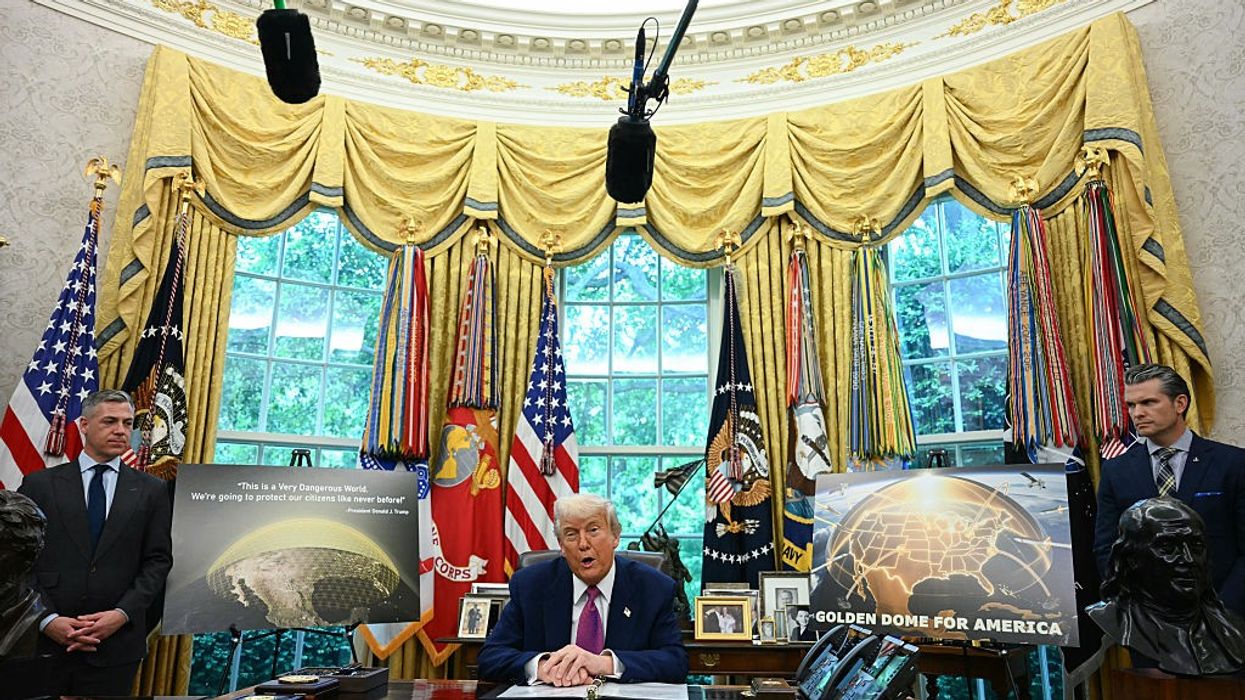Under Trump, War Profiteers Are Entering a New Golden Age
The "garrison state" Eisenhower warned of has arrived, with negative consequences for nearly everyone but giant weapons conglomerates and their competitors in the emerging military-tech sector.
When, in his 1961 farewell address, President Dwight D. Eisenhower warned of the dangers of the unwarranted influence wielded by a partnership between the military and a growing cohort of U.S. weapons contractors and came up with the ominous term “military-industrial complex,” he could never have imagined quite how large and powerful that complex would become. In fact, in recent years, one firm — Lockheed Martin — has normally gotten more Pentagon funding than the entire U.S. State Department. And mind you, that was before the Trump administration moved to sharply slash spending on diplomacy and jack up the Pentagon budget to an astonishing $1 trillion per year.
In a new study issued by the Quincy Institute for Responsible Statecraft and the Costs of War Project at Brown University, Stephen Semler and I lay out just how powerful those arms makers and their allies have become, as Pentagon budgets simply never stop rising. And consider this: in the five years from 2020 to 2024, 54% of the Pentagon’s $4.4 trillion in discretionary spending went to private firms and $791 billion went to just five companies: Lockheed Martin ($313 billion), RTX (formerly Raytheon, $145 billion), Boeing ($115 billion), General Dynamics ($116 billion), and Northrop Grumman ($81 billion). And mind you, that was before Donald Trump’s Big Beautiful Budget bill landed on planet Earth, drastically slashing spending on diplomacy and domestic programs to make room for major tax cuts and near-record Pentagon outlays.
In short, the “garrison state” Eisenhower warned of has arrived, with negative consequences for nearly everyone but the executives and shareholders of those giant weapons conglomerates and their competitors in the emerging military tech sector who are now hot on their trail. High-tech militarists like Peter Thiel of Palantir, Elon Musk of SpaceX, and Palmer Luckey of Anduril have promised a new, more affordable, more nimble, and supposedly more effective version of the military-industrial complex, as set out in Anduril’s “Rebooting the Arsenal of Democracy,” an ode to the supposed value of those emerging tech firms.
Curiously enough, that Anduril essay is actually a remarkably apt critique of the Big Five contractors and their allies in Congress and the Pentagon, pointing out their unswerving penchant for cost overruns, delays in scheduling, and pork-barrel politics to preserve weapons systems that all too often no longer serve any useful military purpose. That document goes on to say that, while the Lockheed Martins of the world served a useful function in the ancient days of the Cold War with the Soviet Union, today they are incapable of building the next-generation of weaponry. The reason: their archaic business model and their inability to master the software at the heart of a coming new generation of semi-autonomous, pilotless weapons driven by artificial intelligence (AI) and advanced computing. For their part, the new titans of tech boldly claim that they can provide exactly such a futuristic generation of weaponry far more effectively and at far less cost, and that their weapons systems will preserve or even extend American global military dominance into the distant future by outpacing China in the development of next-generation technologies.
War and a Possible Coming Techno-Autocracy
Could there indeed be a new, improved military-industrial complex just waiting in the wings, one aligned with this country’s actual defense needs that doesn’t gouge taxpayers in the process?
Don’t count on it, not at least if it’s premised on the development of “miracle weapons” that will cost so much less and do so much more than current systems. Such a notion, it seems, arises in every generation, only to routinely fall flat. From the “electronic battlefield” that was supposed to pinpoint and destroy Viet Cong forces in the jungles of Southeast Asia in the Vietnam War years to Ronald Reagan’s failed vision of an impenetrable “Star Wars” missile shield, to the failure of precision-guided munitions and networked warfare to bring victory in Iraq and Afghanistan during this country’s Global War on Terror, the notion that superior military technology is the key to winning America’s wars and expanding U.S. power and influence has been routinely marked by failure. And that’s been true even if the weapons work as advertised (which all too often they don’t).
And while you’re at it, don’t forget, for example, that, nearly 30 years later, the highly touted, high-tech F-35 combat aircraft — once hailed as a technological marvel-in-the-making that would usher in a revolution in both warfare and military procurement — still isn’t ready for prime time. Designed for multiple war-fighting tasks, including winning aerial dogfights, supporting troops on the ground, and bombing enemy targets, the F-35 has turned out to be able to do none of those things particularly well. And to add insult to injury, the plane is so complex that it spends almost as much time being maintained or repaired as being ready to do battle.
That history of technological hubris and strategic failure should be kept in mind when listening to the — so far unproven — claims of the leaders of this country’s military-tech sector about the value of their latest gadgets. For one thing, everything they propose to build — from swarms of drones to unpiloted aircraft, land vehicles, and ships — will rely on extremely complex software that is bound to fail somewhere along the way. And even if, by some miracle, their systems, including artificial intelligence, work as advertised, they may not only not prove decisive in the wars of the future but make wars of aggression that much more likely. After all, countries that master new technologies are tempted to go on the attack, putting fewer of their own people at immediate risk while doing devastating harm to targeted populations. The use of Palantir’s technology by the Israeli Defense Forces to increase the number of targets devastated in a given time frame in their campaign of mass slaughter in Gaza could foreshadow the new age of warfare if emerging military technologies aren’t brought under some system of control and accountability.
A further risk posed by AI-driven warfare is the possibility that the new weapons could choose their targets without human intervention. Current Pentagon policy promises to keep a human “in the loop” in the use of such systems, but military logic runs counter to such claims. As Anduril President and Chief Strategy Officer Christian Brose has written in his seminal book Kill Chain, the high-tech wars of the future will hinge on which side can identify and destroy its targets most quickly — an imperative that would ensure slow-moving humans were left out of the process.
In short, two possibilities arise if the U.S. military transitions to the “new improved” military-industrial complex espoused by the denizens of Silicon Valley: complex systems that don’t perform as advertised, or new capabilities that may make war both more likely and more deadly. And such dystopian outcomes will only be reinforced by the ideology of the new Silicon Valley militarists. They see themselves as both the “founders” of a new form of warfare and “the new patriots” poised to restore American greatness without the need for a democratic government in the war-making mix. Their ideal, in fact, would be to ensure that the government got out of the way and let them solve the myriad problems we face alone. Ayn Rand would be proud.
Such a techno-autocracy would be far more likely to serve the interests of a relatively small elite than aid the average American in any way. From Peter Thiel’s quest for a way to live forever to Elon Musk’s desire to enable the mass colonization of space, it’s not at all clear that, if such goals could even be achieved, they would be generally available. It’s more likely that such opportunities would be restricted to the species of superior beings that the techno-militarists see themselves as being.
The Ultimate Brawl Between the Big Five and the Emerging Tech Firms?
Still, the techno-militarists face serious obstacles in their quest to reach the top rungs of power and influence, not least among them, the continued clout of old-school weapons makers. After all, they still receive the vast bulk of Pentagon weapons spending, based in part on their millions of dollars in lobbying and campaign expenditures and their ability to spread jobs to almost every state and district in the country. These tools of influence give the Big Five far deeper roots in and influence over Congress than the new tech firms. These large, legacy companies also influence government policy through their funding of hawkish think tanks that help shape government policies designed to regulate their conduct, and so much more.
Of course, one way to prevent the ultimate brawl between the Big Five and the emerging tech firms would be to feed them both with ample funding — but that would require a Pentagon budget that would soar well beyond the present trillion-dollar mark. There are, of course, some projects that could benefit both factions, ranging from Donald Trump’s pet Golden Dome missile defense scheme, which could incorporate hardware from the Big Five with software from the emerging tech firms, to Boeing’s new F-47 combat aircraft program, which calls for unpiloted “wing men” likely to be produced by Anduril or another military tech firm. So, the question of confrontation versus cooperation between the new and old guard in the military sector has yet to be settled. If the rival firms end up turning their lobbying resources against each other and going for each other’s proverbial throats, it could weaken their grip on the rest of us and perhaps reveal useful information that might undermine the authority and credibility of both sides.
But count on one thing: neither sector has the best interests of the public in mind, so we need to prepare to fight back ourselves regardless of how their battle plays out.
Okay, then, what could we possibly do to head off the nightmare scenario of a world run by Peter Thiel, Elon Musk, and crew? First, we’ll need the kind of “alert and knowledgeable” citizenry that Dwight D. Eisenhower pointed to so long ago as the only antidote to an ever more militarized society. That would mean concerted efforts by both the public and the government (which would, of course, have to be run by someone unlike Donald J. Trump — already a project in itself!).
At the moment, the tech sector is indeed increasingly embedded in the Trump administration and he owes a number of them a distinct debt of gratitude for helping him over the top in the 2024 election. Despite his very public and bitter falling out with fellow narcissist Elon Musk, the influence of the tech sector within his administration remains all too strong, starting with Vice President J.D. Vance, who owes his career to the employment, mentoring, and financial support of Silicon Valley militarist Peter Thiel. And don’t forget that a substantial cohort of former employees of Palantir and Anduril have already been given key posts in this administration.
Creating a counterweight to those new-age militarists will require a full-scale societal effort, including educators, scientists, and technologists, the labor movement, non-tech business leaders, and activists of all stripes. Silicon Valley workers did, in fact, organize a number of protests against the militarization of their handiwork before being beaten back. Now, a new wave of such activism is all too desperately needed.
Just as many of the scientists who helped build the atomic bomb spent their post-Hiroshima and Nagasaki lives trying to rein in or abolish nuclear weapons, a cohort of scientists and engineers in the tech sector needs to play a leading role in beginning to craft guardrails to limit the military uses of the technologies they helped develop. Meanwhile, the student movement against the use of U.S. weapons in Gaza has begun to expand its horizons to target the militarization of universities writ large. In addition, environmentalists need to double down on criticisms of the immense energy requirements needed to power AI and crypto, while labor leaders need to reckon with the consequences of AI destroying jobs in the military and civilian sectors alike. And all of this has to happen in the context of a far greater technological literacy, including among congressional representatives and workers in government agencies charged with regulating the suppliers of new military technologies.
None of that is, of course, likely to happen except in the context of a resurgence of democracy and a committed effort to fulfill the unmet rhetorical promises that undergird the myth of the American dream. And speaking of contexts, here’s one that anybody preparing to protest the further militarization of this society should take into account: contrary to the belief of many key figures from the Pentagon to Wall Street to Main Street, the peak of American military and economic power has indeed passed, never to return. The only rational course is to craft policies that maintain American influence in the context of a world where power has been defused and cooperation is all too essential.
Such a view, of course, is the polar opposite of the bombastic, bullying approach of the Trump administration, which, if it persists, will only accelerate American decline. And in that context, the key question is whether the widespread harm inherent in the new budget bill — which will only continue to wildly enrich the Pentagon and big arms firms of both kinds, while hitting the rest of us across the political spectrum — could prompt a new surge of public engagement and a genuine debate about what kind of world we want to live in and how this country could play a constructive (rather than destructive) role in bringing it about.


